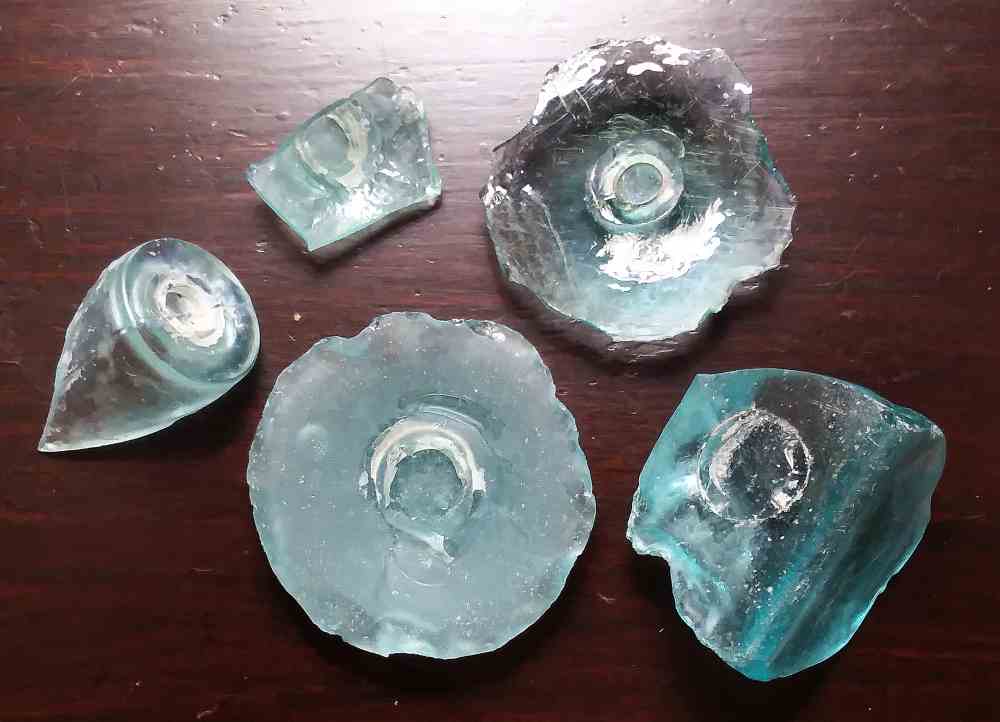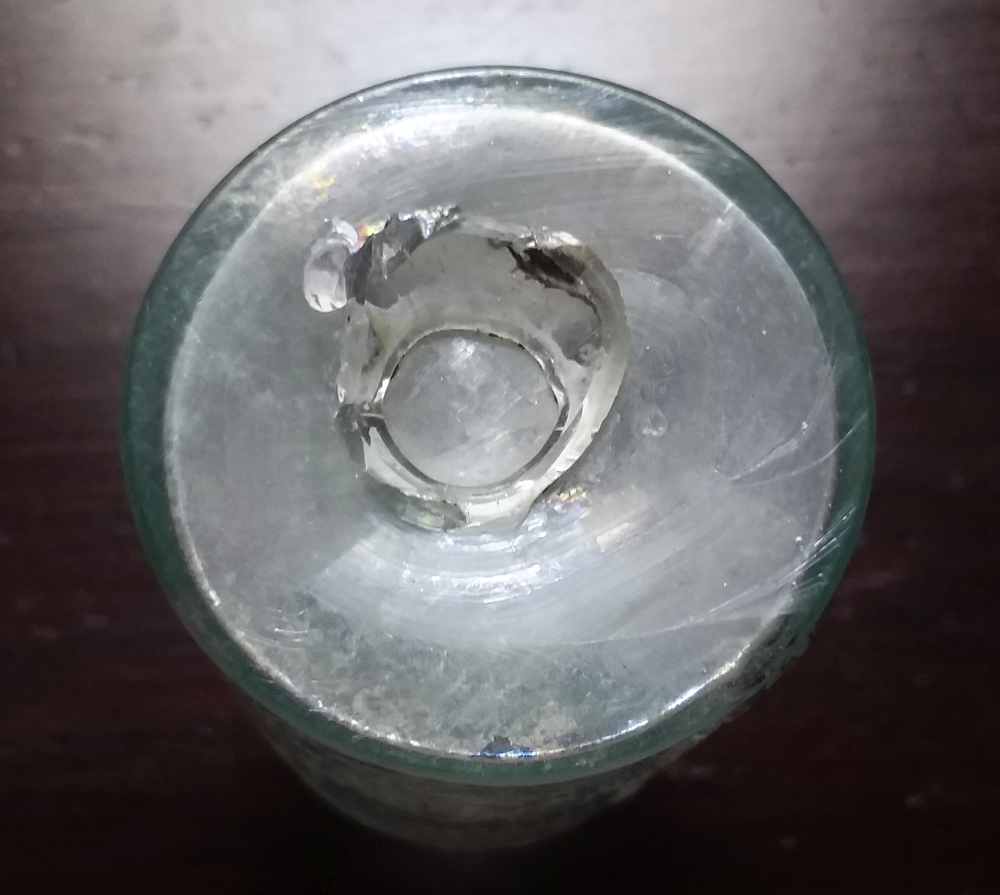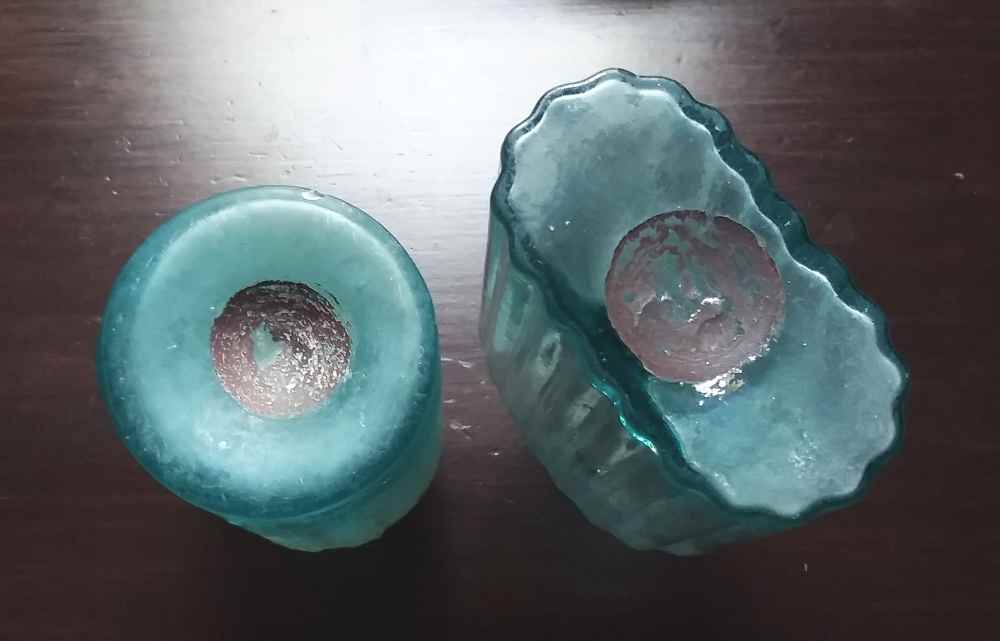PONTIL MARKS ON ANTIQUE GLASS BOTTLES
The subject of Pontil Marks is one of the more confusing aspects of bottle collecting. The terms are often used haphazardly, by collectors and non-collectors alike, as well as by casual ebay sellers, flea market dealers and others who have misunderstood what a pontil mark really is.
(Within the field of bottles), pontil marks are seen ONLY on the bases of handmade (mouth blown) bottles and jars, NEVER on machine-made containers. If you are searching for info on a machine-made glass container (or, for that matter, any type of machine-made glass item including tableware pieces) you can be assured that it does NOT bear a true pontil mark. Pontil marks are only found on handmade ware. Other types of marks (such as the “Owens Scar”) are sometimes erroneously called “pontil marks” by non-collectors.
“Valve marks” (Ejection marks) ,which are usually perfectly round and typically about the size of a nickel or US cent, and seen on the bottoms of machine-made, wide-mouth jars and canisters, are also often mistakenly called “Pontil Marks” – both on ebay, on YouTube videos and even occasionally in some “authoritative” online articles.
So here on this page I will illustrate the two most common, basic types of true pontil marks that may be seen on antique bottles that were MADE IN THE UNITED STATES. (There are other types, such as the sand pontil which are seen by collectors, but which will not be discussed here. For more info on the sand pontil and other types of pontil marks, please check the link below on this page pointing to the article by Bill Lindsey).
These two types include the “OPEN PONTIL” or “broken pontil” (featuring a circular broken area or scar on the base of the bottle that can sometimes be sharp enough to cut your finger on); and the “IRON PONTIL ” (also called Improved Pontil and sometimes “Graphite Pontil”) which is a (usually) circular black or reddish mark left on the bottom of the bottle.
ADVERTISEMENT
OPEN PONTIL The open pontil scar occurred when an iron pontil rod (a long iron rod) was temporarily affixed to the bottom of the unfinished bottle (“glued” with a bit of molten glass)- to hold it steady while the lip of the bottle was being fashioned. After the lip is finished the iron rod is then “snapped off” and the scar is left from where the rod was attached to the bottle.
Most “Open pontil” antique utilitarian bottles date from before about 1865, but with some exceptions here and there.


IRON PONTIL The “Iron Pontil” mark was created when the iron pontil rod was directly attached to the bottom of the bottle, and when removed, traces of the iron residue from the top of the rod remained on the surface of the glass. The iron pontil bottles typically date from about 1845 to circa 1863, but there are exceptions, both before and after those years. The use of the pontil rod was gradually phased out around the time of the Civil War, with the advent of the use of the “Snap Case” grasping tool which held the bottle steady while the lip was being formed.

The following webpage (written by researcher, author and bottle collector Bill Lindsey) delves into much more detail on the types of pontil marks that may be seen. I suggest studying this page for more in-depth understanding of the variety of pontil marks the collector might run across in their search for antique bottles:
https://sha.org/bottle/pontil_scars.htm
PONTIL MARKS SEEN on HANDMADE glassWARE (OLD & NEW), art glass, TABLEWARE, novelty glass, OFFHAND GLASS WHIMSIES, etc.
Info about the pontil marks illustrated above on this webpage applies to antique utilitarian bottles made in the US, and does NOT address pontil marks that are often seen on art glass, handmade tableware, artisan whimsies, etc.
The pontil marks seen on the bottoms of art glass pieces and other handmade tableware such as bowls, decanters, vases, and other types of items are a separate field and the rules for their dating may or may not be quite the same as that discussed above for utilitarian types of bottles made in the US before the Civil War era. Art glass pieces will often bear an authentic pontil mark (sometimes the pontil mark is partially or wholly erased – a “polished pontil”) BUT theoretically it could be a new item, even an item that was made a few weeks ago!
Here is a good informational video on Youtube that explains some of the different types of pontil marks seen on antique tableware, primarily European glass before 1900, including some pieces that date back to the early 1700s. In this video, the “open pontil” is termed a “broken pontil”:
“GLASS PONTIL MARKS” video – posted on Youtube by the “LOVE DECANTERS” channel
Please click here for my site Welcome / Home Page
ADVERTISEMENT

